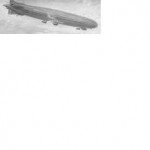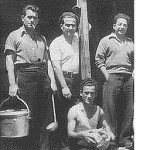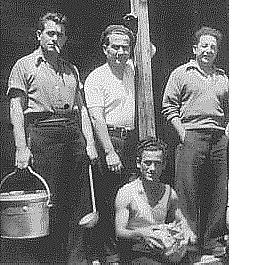By Arthur Woodgate
On 16 October 1917, I was taken to the Lion Street School and settled in a class taught by a Miss Jordon. Miss Longley was the Headmistress and with a long wooden corridor she could be heard coming with loud creaks all over our infant school.
The girls had a different mistress and a proper terrorist she was. She had to go through our playground to get to her school and she always had a bike. We were told that we must always stand still when she came pushing her bike amongst us. If we didn’t obey this we were severely told off. This lady could be bit spiteful.

No evacuating of schools in the First World War which started in 1914. I was 5 years old when I heard my first Zeppelin. We were at our desks when “mu-mu-m” drone. We stayed at our desks throughout the rest of the war, no lumbering us all off to Bedford. The classroom window faced Lion Street and a slight turn to my right and I could see the Town Hall and the North Door of Rye Parish Church. So we were sitting inside the middle of all that was important to our little town. The Zeppelin went passed over Rye and dropped some bombs at Rye Harbour, close to the Harbour House breaking all the windows as the stones flew up. No one was killed and none very badly injured. We were still were at our desks and heard the bombs explode.
When we were seven years old we were moved into a little school in Mermaid Street, which in later years became Rye Boys Club. So here we were in Mermaid Street where I spent the rest of my time at school and some of my time as a workman. My home and school at that time could be seen from each other so I could see if a monitor was on the school gate to report to the teachers if we were late and give the punishment for such. I never knew why the gate had to be watched as there was a door to the building just inside the gate. I supposes they had to do something like this to satisfy those pupils who loved ratting on those who should be friends and do more to defend them than rat.
It was here that that great teacher joined the Rye Team of School teachers. Herbert Sydney Allnut – he came to Rye from Winchester and we were his first class, some of us had him stay with us for the rest of his teaching time. He was a great asset to the town as well as the Schools. He was a great lover of sport. I don’t understand football but he took hold of Rye Teams and combined them into the once mighty Rye United. He helped to convert the town’s drainage tank where he taught many to swim, including me – not the ideal swimming pool but much better than nothing and it encouraged enthusiasm for swimming, a legacy that is now reflected in the fine pool at Rye Sports Centre that is enjoyed by so many in this community.
After the First War the Zeppelin terror weapons were developed into commercial airships and seen as a fast alternative to liners for long distance travel. In 1919 the R34 made the first double crossing of the Atlantic but the Germans with their Zeppelins were never far behind. The R100 built by Vickers, and the R101 built at the Royal Airship Works in Cardington were leading British designs in the airship race for supremacy. Construction of the R100 and R101 began in 1927.
The R100 was a conventional airship. Its first flight was on 17 December 1929. It was the fastest and finest rigid airship built in Britain. It left for Montreal, Canada on 29 July 1930. The outward and return journeys were equally successful. The R100 moored at Cardington on 16 August 1930 but events dictated it would never fly again. 56 days later on 5 October 1930, the R101 put an end to commercial flights in British airships when it crashed on it’s twelfth flight at Beauvais in France, on route to India, and burst into flames with the loss of 48 lives.
The German interest in giant commercial Airships continued until 1937. It ended when the Hindenburg burst into flames as it came into land at Lakehurst, New Jersey. 36 people died in the conflagration.
The Regent Cinema was the main entertainment in Rye town between the war years. I helped build the original Regent. In the pre SecondWorld War years I spent quite a bit of time dealing with old houses of different periods. Slate roofs needed all sorts of tricks to keep the rain out Metallic tiles had been used as hanging tiles on many houses about town. They were difficult to get hold of, not many of these tiles were ever made, and when the war came production of them was ceased. But this cut no ice with the War Commission who ruled that these sort of tile were to be used where they had been before.
Tenterden had been another town to have used them so off to that Kent Town I went and interviewed a builder there. He had been lucky enough to find some and had them stacked in his yard but would not sell to me. I went to do a job in Watch Street found some laid flat on his garden for paths! He wouldn’t let me talk him into parting with them – still no luck. I tried all sorts of contacts but nothing so in the end I got a bundle of batons and set them up a load of moulds to cast some. This worked but being thin, soon got brittle, they had to be a strong mix with some Cementone colouring and right gauge but, in the end I made plenty to fit in where I had them missing and if anyone even goes and looks now they won’t pick out my home-made patches.
I was called up early in the War but was sent back to myprewar job, told to release my old staff and continue with new staff and later some prisoners of war – to carry on with the building an oast. Lots of prisoners were working with the same farmer but in a different department but close enough to sit down and eat our main meal together. Many were better educated than us, some could speak very good English. I got to know an Austrian quite well. We shared each others meal seats, a stack of bags of cement just inside an open shed. He asked me if I could talk to him about the establishment and running a domestic government because, he said, we are not going to put up with dictatorship when the world settles down to peace again and certainly not an Adolf Hitler. So, every dinner time I tried to give him an idea of how Parliament works in England.

Taken away from my Oast House for a while to build a farm office, I met up with another lot of prisoners of war, Italians this time. They were putting in land drains into very narrow trenches – they had their full field kitchen and their cooks. One of the kitchen staff fell down the steps while carrying a large saucepan of boiling water, I suspected a serious back injury – Fortunately one of my St. John Ambulance colleagues, Arthur Luck was working in the house. We didn’t have much first aid equipment so we improvised. I started to dish out orders to an Italian who spoke English. First I need a farm wattle gate for a stretcher then a bundle of straw to form a mattress covered by some hop sacks. Then a couple of hop pockets for top blankets. It so happened I had some triangle bandages with me which I had been using for demonstration and practice so with collecting some short pieces of wood to push the bandages through and some longer pieces for splinting, were ready to move. The ambulance and doctor both arrived and the doctor tested this for unnatural movement and off we went to the Royal East Sussex Hospital. My straw packing and secure bandaging and packing looked a bit of a mess but I had to bring the nurses to book after which they gave us a cup of tea each and the Italian soldier was soon cleaned up and recovering. The Italian Commander sent me a thank you letter and their cooks invited my mates and I to share their main meals from their field kitchen.
Pictures from the Woodgate Collection
“Rye’s Own” March 2015
All articles, photographs and drawings on this web site are World Copyright Protected. No reproduction for publication without prior arrangement.
